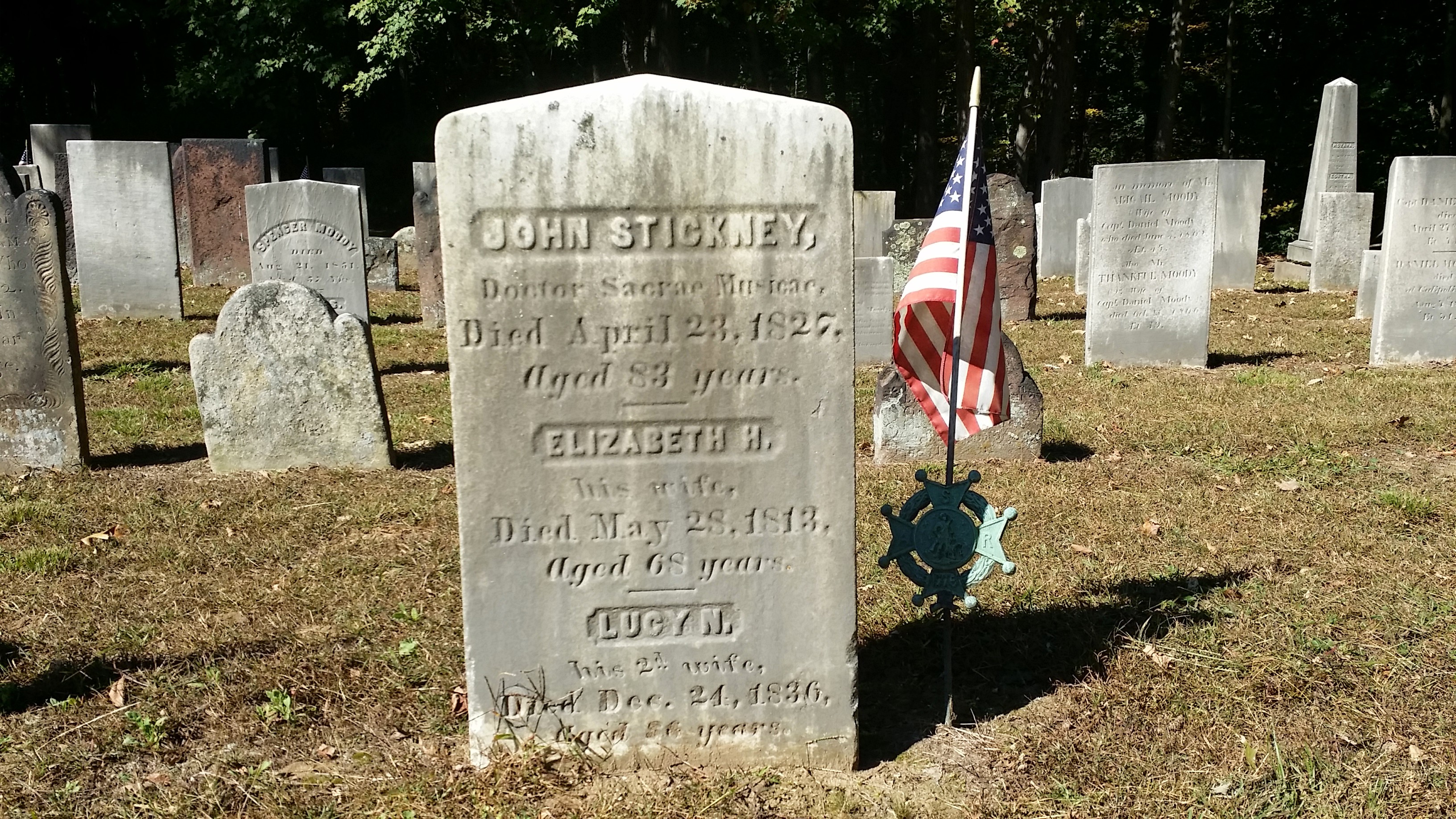Having requested a microfilm some weeks ago, I headed off to the LDS Family History Center (FHC) in Lynnfield, Massachusetts, to review the vital records of Waterbury, Connecticut. The initial goal was to confirm the name and origins of Ellen Holland (3rd GGM), husband of John Wallace Stickney and mother to Ellen Augusta Stickney (my 2nd GGM), and to get the birth information for Ellen. Continue reading Wire Drawer: My first trip to an FHC
Tag Archives: Stickney
Ellen Holland’s parents, Come On Down!
While Google and Ancestry.com have gotten me to incredible places on my family tree, I am at a point now where it’ll take a few more dollars to break down the brick walls and add another generation. Case in point, requested the Marriage Certificate for John Wallace Stickney and Ellen Holland. Date of Marriage: 2 November 1868 in New York. Up until this point, I knew almost nothing beyond Ellen’s name. Here is the new information:
- Father’s Name: John Holland
- Mother’s Name: Ma* Donnelly
- Place of Birth: (illegible)
- Age at Marriage: 22 (birth abt 1846)
In addition to the brand spankin’ new info above, I also got these oddities about “John Wallace”:
- For some reason, his name is listed at Jaques W. Stickney.
- His birthplace is listed as Illinois, though I have other documentation listing Massachusetts.
Why did he list his name as Jaques? One of his siblings was born in Illinois, so it’s not out of the questions, just a surprise. His parents are confirmed as John Stickney and Sarah Caty (sp – Cady).
Can someone help me figure out where Ellen Holland listed her birthplace? To me it doesn’t look like any known state. Leave a comment with you best guess please. 🙂
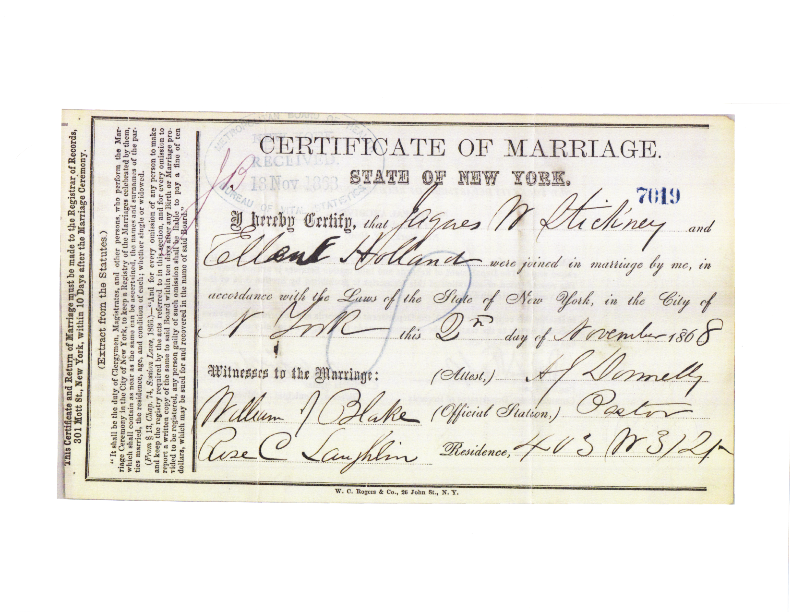
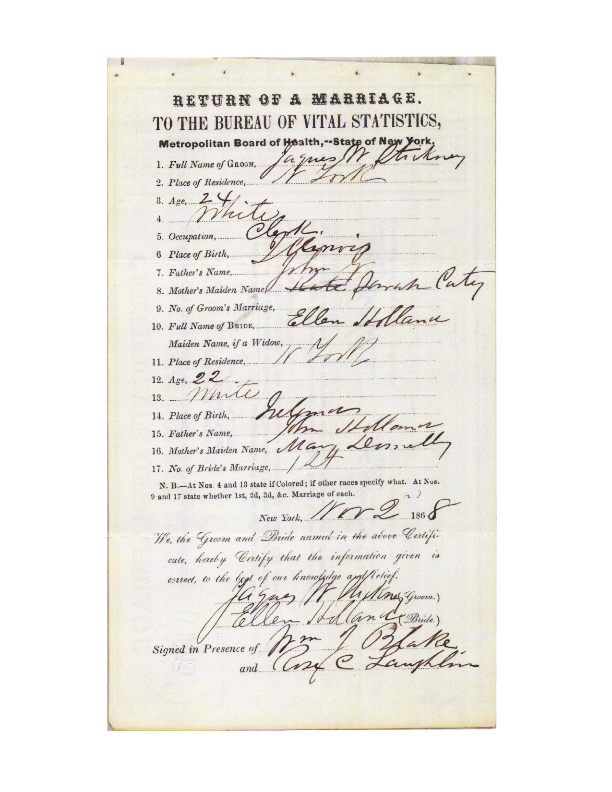
J. W. Stickney, Mutual Waterbury Hook and Ladder company
Found this little nugget in “The Town and City of Waterbury, Connecticut, from the aboriginal period to the year eighteen hundred and ninety-five”
A meeting was called, September 28, 1872, in the rooms of “Phoenix, No. i,” for the purpose of forming a Hook and Ladder company, the city having before this date purchased a Leaverich truck. The company was organized with the following members:
E. L. Cook, C. L. Tinker, Charles Lawton,
I. A. Spencer, Robert Philip, E. E. Cargill,
T. D. Bassett, William Cowel, Charles Olmstead,
B. F. Merrill, Theodore Rogers, J. W. Stickney,
J. W. Gaffney, R. P. Smith, Frank White,
F. A. Hoyt, Alexander Connison, Stephen Hosier,
C. L. White, Edward Barritt, Daniel Nehemiah.
F. L. Wallace, G. W. Roberts,
The officers elected were as follows :
Foreman, Theodore D. Bassett.
First assistant. E. S. Cooke.
Second assistant, G. W. Roberts.
Secretary, R. P. Smith.
Treasurer, Imri A. Spencer.
At a meeting September 28, 1872, in the rooms of “Phoenix No. 1”, a Hook and Ladder Company was formed, the city having before this date purchased a Leaverich truck. The company took possession of its first house, on the corner of Scovill and South Main Streets in August, 1873.
For twelve years the truck was hauled to fires by the men themselves, but in 1884 an arrangement was made, by which hack horses could be used for fires occurring at a distance from the centre. In 1887 two horses were purchased for the use of the truck, and William Goucher was installed as driver. In the same year the company removed to the present house on Scovill Street under the same roof with Engine No. 2. In May, 1889, the city purchased a Preston aerial truck, sixty-five feet long, and was drawn for a time by two horses, but later it was arranged for a “three horse hitch”.
Hook and Ladder Company No. 1, was the first to adopt the regulation uniforms, it also possesses portraits in oil of all the foremen of the company up to the present time, and a large picture of the company taken in 1881.
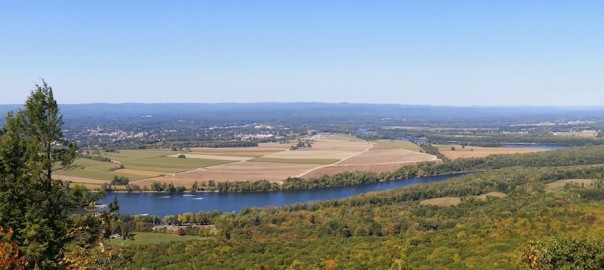
Paying my respects to John Stickney
On a recent trip to the Pioneer Valley of Massachusetts with my wife for our third wedding anniversary, I took advantage of being in South Hadley to visit to the relocated Old Burial Ground at the Evergreen Cemetery. Having rushed in preparing for a few genealogical stops on this trip, I didn’t know what the layout of the cemetery was, or where my ancestor’s headstone was in relation to the entrance.
Upon entering the cemetery, I noticed that there were many historic headstones mixed with more recent headstones throughout, so I determined I would have to look at each one in the hopes of finding the right one. After about 20 minutes or so, I thought I would check Find-a-Grave for a picture of the headstone so I would have a better idea of what I was looking for. After doing that, and noting the stones and trees in the background of the posted image, I knew it had to be on the edges.
It was about this time that I noticed over a hill an area that was set aside from everything else with a marker on a large boulder at the entrance of this hallowed ground. Sure enough, this was the relocated old burial ground. After another 20 minutes of seemingly looking at each row twice, and on the verge of giving up since it was hot and my wife and dog were patiently waiting for me on a bench at the entrance of the cemetery, I took a look at one row one last time, and that’s when I saw what I had hoped to find:
John Stickney, musician and composer
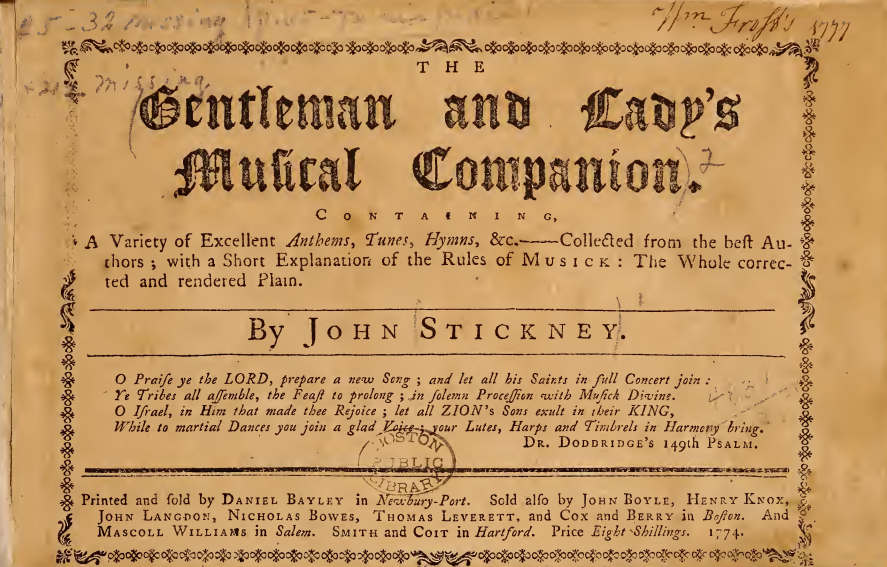
My 6th great grandfather (paternal), John Stickney, was born in 1742/1744 in Stoughton, Norfolk, Massachusetts, and died in South Hadley, Massachusetts in 1804. Here is some fascinating information about his life as a musician:
STICKNEY, John, musician, b. in Stoughton, Mass., in 1742; d. in South Hadley, Mass., in 1826. He was taught music while a boy, and subsequently settled in Hatfield, where he gave lessons. Later he travelled extensively through the New England states, and acquired reputation as a teacher and composer, but finally settled in South Hadley, where he continued his teaching. He published “The Gentlemen and Ladies’ Musical Companion” (Newburyport, 1774), a valuable collection of psalms and anthems, together with explanatory rules for learning to sing.
Source: Appleton’s Cyclopædia of American Biography, Volume 5, edited by James Grant Wilson, John Fiske. LINK
And also this:
In 1774 John Stickney, teacher of music, published at Newburyport, Massachusetts, “The Gentlemen and Ladies’ Musicial Companion,” a small, but in its time a very valuable collection of psalms and anthems, together with explanatory rules for learning to sing; the whole corrected and rendered plain by the author. John Stickney was born in Stoughton, Massachusetts, in 1742; and while a butcher boy he learned the new style of music, near boston, of one Dunbar; went to Hatfield, and there taught the new music to all such as desired to learn it, and afterwards taught in all the principal towns in that region, but not without much opposition from those who preferred the old style, or that of the Pilgrims. For many years the wife of Mr. Stickney taught music with him, she being a very excellent singer, and having a powerful voice; she travelled with him from place to place, and was an excellent assistant. They finally settled at South Hadley, and continued to teach until John was sixty-five years old. Mr. Stickney died in 1826. His book was printed by Daniel Bailey, of Newburyport, who printed many of the early collections. The music was engraved, and is like other specimens of that time.
Source: Complete Encyclopædia of Music: Elementary, Technical, Historical, Biographical, Vocal, and Instrumental. John Weeks Moore (J. P. Jewett, 1854) – LINK
And finally this from Daniel T.V. Huntoon’s History of The Town of Canton, Massachusetts (1893), CHAPTER XVIII :
Rev. Theron Brown says “the ancient town of Stoughton, which included the present Canton, was the cradle of New England middle-age psalmody, – that strange, quaint, minor mode, with its ‘ down, up ‘ time and its complicated fugues, whose most characteristic specimens are now presented and performed as musical curiosities. ‘ Portland ‘ and ‘ Lenox ‘ and ‘ Windham,” Lebanon ‘ and ‘ Majesty,’ ‘ New Jerusalem ‘ and the ‘ Easter Anthem,’ were all born upon the soil; and the familiar Canton names of Capen, Tilden, Tolman, French, Dickerman, and Belcher appeared ninety years ago on the list of the singing class of William Billings.” Long before the singing-school of Billings, a young man named Elijah Dunbar learned while going through Harvard College, in addition to his Greek and Latin, the art of reading music. On his graduation in 1760, he returned to his native town and at once organized a singing-school and gave to his neighbors the benefit of his knowledge.
In 1762 I learn from the ” History of Dorchester ” that” there was a singing meeting at Stoughton,” and two years later I have evidence that there was an organization in working order for the purpose of practising in vocal music. This was the year the small-pox visited Canton, and it was deemed expedient to send word to the Bridgewater singers who were wont to attend not to come over. Singing meetings were held at the houses of neighbors; sometimes it would appear that they had ” prodigious jangling.” On the 13th of December, 1764, when William Billings was married to Mary Leonard, there were more than forty persons at the wedding, and the singing must have been very fine. Mr. John Stickney seems to have known something about the art, for when Jesse Billings came from Hatfield, and wanted some one to teach them to sing, Stickney went to their assistance. In 1766 ” our singers are at Mr. Adams’s.” John Kenney, a fine bass singer, went with Elijah Dunbar to Boston to buy new books the same year; and they on March 19 ” draw books and sing the old 50th the first time.” On Feb. ri, 1767, the Braintree singers came to Canton, but got into a religious discussion and had ” a remarkable time;” subsequently they met at the old May tavern on March 9, all the differences were made up, and ” there seems to be great love and harmony.” On August 4, they have in the old gambrel-roofed house still standing at Ponkapoag ” sweet singing at Elijah Crane’s,” and on the 24th ” fine fidling.” In 1770 new books were introduced; and on the 2 ist of December, they were used in the house of Samuel Capen for the first time. During the interval from the year 1764 to 1774, the principal persons belonging to this society, or the persons at whose houses they met, were: Elijah Dun-bar, Elijah Crane, Squire Dickerman, John Stickney, John Kenney, Samuel Capen, Enoch Leonard, John McKendry, Thomas Crane, Henry Stone, Theophilus Lyon, Robert Redman, George Blackman, Philip Liscom, Asahel Smith, Samuel Tilden, Wadsworth Talbot, Abner Crane, William Patrick, Benjamin Gill, Jeremiah Ingraham, John Withington.
In 1774 William Billings, then twenty-eight years of age, gave instruction in music, or, as they would have said, taught a singing-school in the tavern of Robert Capen. He interested the young people of Stoughton in his work, inspired them with his own enthusiasm, organized them into choirs, taught them to despise foreign music, especially that of England, and jumbled religion and patriotism into his stanzas with such a grace that he became the most successful organizer of music in America.
War for American Independence Veterans
Paternal:
Thomas Barclay – Was a gallant soldier in the American army during the revolutionary war. On July 12, 1776, he enlisted from St. Mary’s county, Maryland, in the “Flying Camp”, in which organization he served for some time. In 1779, he was a member of Major Anderson’s battalion of the Third Maryland Regiment, which served in General Washington’s command in New Jersey. While serving with his command in Shrewsbury, New Jersey, he met Catherine, daughter of John Williams, whose property had been confiscated by the continental congress, and who was himself a fugitive because of his loyalty to the King.
John Stickney – South Hadley. Private, Capt. James Hendrick’s co. ; pay abstract for mileage to and from headquarters, dated Charlestown, Camp No. 3, Jan. 13, 1776; mileage for 100 miles allowed said Stickney.
Maternal:
Elias Babcock – Elias Babcock (my 5th Great Grandfather), Corporal, Enlisted May 19th, 1777 to 1780 from Partridgefield and Northampton. Elias was in the Battle of Saratoga, and served through the Carolinas with Gen. Gate’s army. He was also at the surrender of Cornwallis, and was in a number of severe battles which occurred during this war.
Isaiah Babcock, Sr – Committee of Safety, 1779, of Parkersfield, Massachusetts (or Partridgeville, Mass.)
John Ives – He has been described as Major. A D.A.R request for information on December 31, 2006 indicates that he was involved in the Revolutionary War as a Patriot providing a service for the cause. (Patriot Service) is the term recognized by the D.A.R. (His is ancestor number: A060740) The D.A.R. has him as sering in Capt. Hough’s Co., 10th Regt. in the capacity of Private in the alarm at New Haven & Fairfield, Ct. on July 5,6,7, 1779 in the 5th Co. in the 10th Regiment. (Collections, CT Historical Soc. Vol VIII, pg 192) CT Mil. 1775-1783, GRC, Vol II pag 117.
Benjamin Hart
Daniel Appleton
Joshua Woodman – Joshua Woodman (1720-1800) enlisted from Buxton in Capt. John Lane’s company, 1775, and gave six short enlistments under different commands in one year. He was born in Newbury, Essex, Mass., and died in Buxton, Maine.
Nathaniel Gilbert, II – Commanded (Captain) a company in the regiment under Col. Comfort Sage when Tryon invaded the State. He was born and died in Middletown, CT.
Nathaniel Gilbert, III – Corporal in Captain Elijah Gilbert’s Eighth Company of Col. William Bradford Whiting’s 17th Albany Co. Regiment.
Willett Ranney, Sr. – His Revolutionary service there was as follows: Private in Capt. Samuel Wolcott’s Co., Col. Hopkins’ Regt., July 16, 1776-Aug. 5, 1776; marched to Highlands, N. Y.; private Capt. Elijah Deming’s Co., Col. John Ashley’s Regt., July 8, 1777-July 28, 1777, called out by order Maj. Gen. Schuyler to march to relief of Fort Edward; private, same Co., Col. John Ashley’s Regt., Sept. 19, 1777-Oct. 4, 1777, under Brig. Gen. Fellows, ordered out by Gen. Gates to reinforce the Northern Army. Rem. 1778 to New Lebanon, N. Y., and was next known with his large family at Fort Stanwix, now Rome, N. Y.
Willett5 Ranney (Willett4, Willett3, Thomas2, Thomas1), bapt. Aug. 6, 1769, with Benjamin, a twin, Upper Houses, was 7 years of age when his father rem. to Sandisfield, Mass. He m. Oct., 1799, Rome, N.Y., Betsey Robbins, dau. of John Robbins, who came from Bennington, Vt., in 1790. In June, 1790, he leased of Gov. Clinton the 100 acres in “Wright’s Settlement,” adjoining the 100 acres his brother Seth had leased the previous year, and which was long known as the “Ranney Place.” He was to pay one peppercorn each year, if lawfully demanded, for four years, and after that 18 bushels of good winter wheat, on May 1 of each year, in the city of Albany. This lease in 1878 was in the possession of his son Lester. He sublet the lease in 1795 to Cornelius Van Warner, and in 1796 leased a 50-acre tract of Moses Wright, while Butler Ranney leased the adjoining tract. In 1801 both Ranneys sold out. He then rem. to Saratoga County, as the Bible record is that Anson was born in the town of Milton in that county. About 1810 he went to Taberg, and after a year settled in Smithville, near .Adams. His aged parents went with him. When news came that the British had attacked Sackett’s Harbor the militia were ordered out and Willett Ranney, Jr., mounted a horse to go to the defense of his country. The old man, inspired by a love of country yet burning in his bosom, and recalling his own experience in the Revolutionary army, said to his son: “Get off that horse and let me go.” The son obeyed and Willett Ranney, Sr., over 80 years of age, mounted the horse and went as a volunteer. In a few years, 1818, the patriot was laid in the grave and the widow about 1821 followed. In 1826 Willett Ranney, no longer known as Jr., bought a farm in Redfield, and resided on it till 1831, when he went back to the homestead at Smithville, and on which he resided till his death in 1865 at the age of 96 years, at the home of his son Lester.
